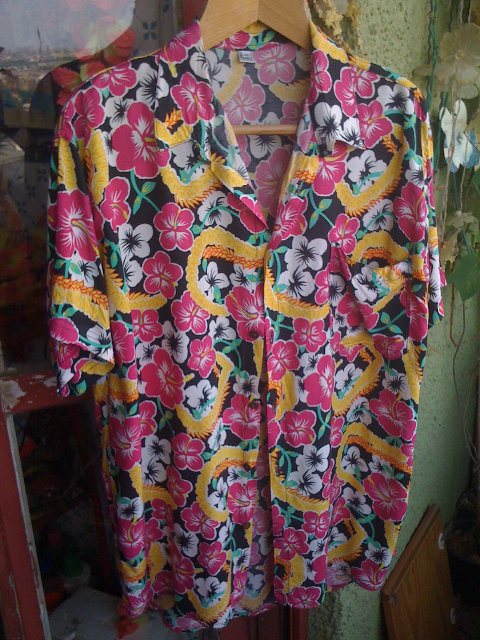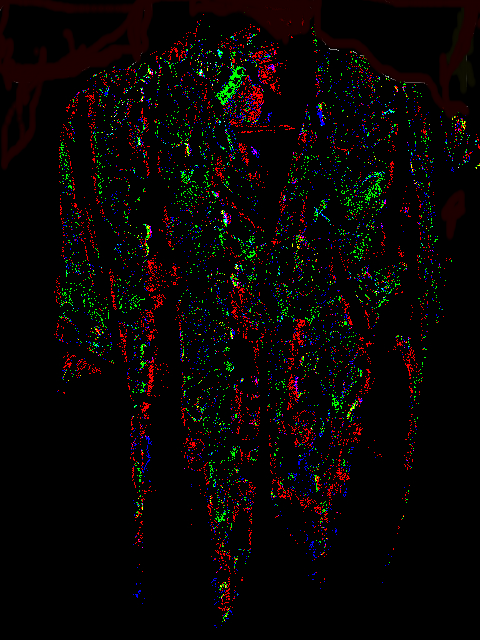MIKE COOPER'S SHIRT, SONIFIED
 Monday, August 22, 2011 at 7:09PM
Monday, August 22, 2011 at 7:09PM The ever amazing Mike Cooper sent me an email the other day, expressing his appreciation for my graphic-to-sound composition Berries. He sent along a photo of a Hawaiian shirt of his, wondering what it would sound like if used as a score in the manner of the Berries photos. Looking at the photo, I realised that it would have to be treated, because all my graphic-to-sound programs use black to indicate silence, and Mike's shirt photo had no black – the picture would be interpreted as fairly dense undifferentiated noise in its untreated state. So I processed the photo through the free image program GIMP. I adjusted the colour curve to be almost all black, and only allowed one small area of the image to come through as other colours. I may have been a bit too severe in my truncating of the colours because, as you can see, only a little bit of the original image survived. Further, since the original photo was pretty low-res (being only 640 x 480 pixels) the result was fairly grainy. However, the manipulated image still looked like it was fairly complex, so I decided to use it, and hear what resulted.

Mike Cooper's Shirt before preparation for graphic synthesis.

Mike Cooper's shirt after preparation for graphic synthesis.
Realised with just sine waves, the result was pretty uninspiring. A bit of twinkle, but that was about it. It then occurred to me that a shirt belonging to a virtuoso guitar and ukulele player like Mike should probably be realised with ukulele or guitar samples instead of sine waves. In my sample collection I have an ancient sample called “Bermuda.” I believe the sample is from around 1988-90, so long ago that I can't remember where its from, or who is playing on it. The sample is of a man playing a guitar or ukulele, singing, and stomping his foot in time with his playing. It's very cheery. Here's the original sample:
"Bermuda" - original sample
I made two very short samples from this, one consisting of the first strummed chords, the second consisting of just three descending notes with a bit of foot stomping thrown in. Here are the two samples.
"Uke 1" - sample 1
"Uke 2" - sample 2
Nicholas Fournel's AudioPaint allows you to use any sample to realise a graphic, not just sine waves or noise. So I realised the processed photo into sound with both samples, producing two short sound files, which I then sent on to Mike. (For those of you who like tech things – Stereo Space was controlled by Red/Green colours; the Duration was either 120 or 180 seconds; and the Frequency Range was from 50 – 12500 Hz; with a Logarithmic Pitch Spread.)
Mike liked the sound of these realisations, and I agreed – the use of the vastly stripped back photo with the guitar/uke samples did indeed produce a fairly exciting sound texture. I thought that was the end of the thing, but my mind wouldn't rest. What if we played the photo horizontally instead of vertically? What if we turned it upside down? What about upside down and backwards? You know, all the usual serialist schticks.
I realised that if I was going to do the serialist thing though, I'd actually have 8 different versions of the picture – the original and the original flipped left-right; upside down and upside down flipped left-right, and the same 4 alterations for the photo flipped horizontally. However, I decided to be loyal to “the tradition” (or I was simply lazy), and only made 4 versions, one each for the standard original, and it upside down; and the horizontal left to right, and right-to-left forms of the photograph.
Two of these pics used the first Uke sample, the other two used the second. I then had four sound files, of different lengths, and I decided on an order for them, which included substantial overlapping, and mixed them together. The result is this little eight minute piece, which I'm quite happy with. It seems to have lots of variety, and the textures change in a really exciting manner. The combination of pitch range, register, the choice of samples, the density of the image, and the durations chosen for each sound file all seem to combine to make an intricate and pleasingly evolving sound texture. The mixing of the four versions enhances this sense of progression as well. Here's the finished piece, with downloads available in both mp3 and ogg formats. I hope you enjoy it.
Download the piece in MP3 format HERE.
Download the piece in OGG format HERE.
 Warren |
Warren | 

